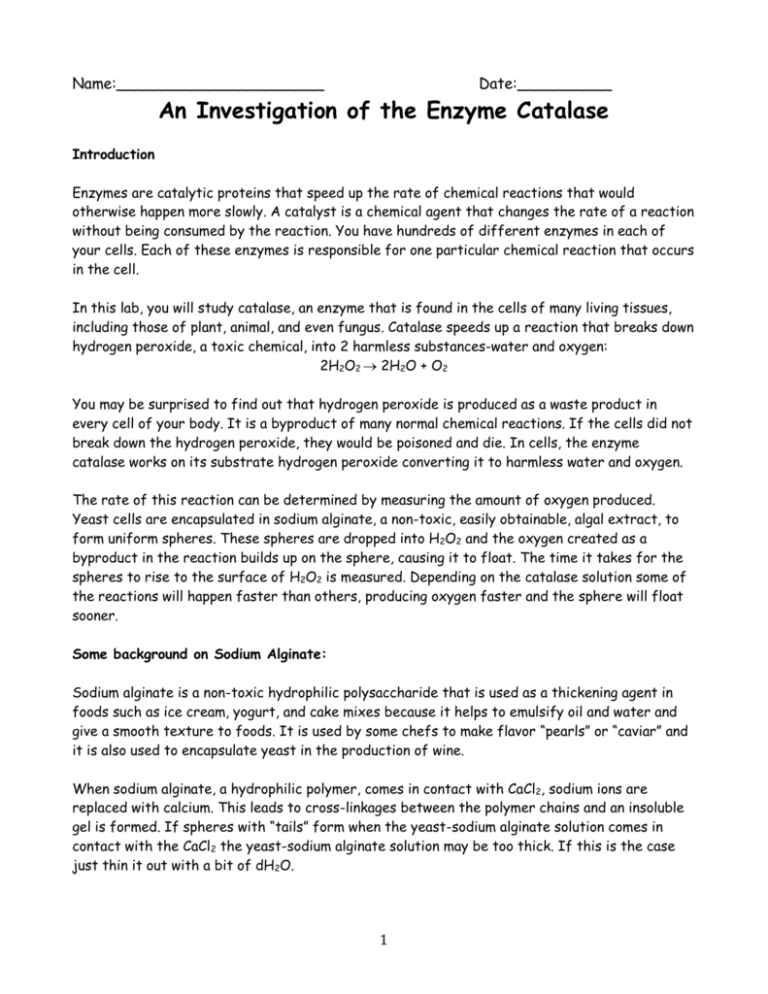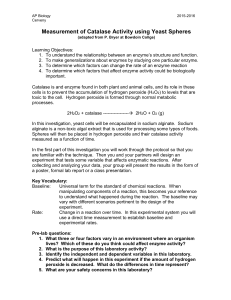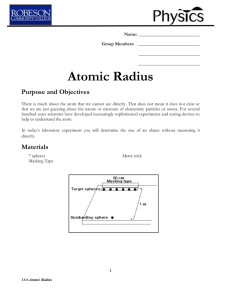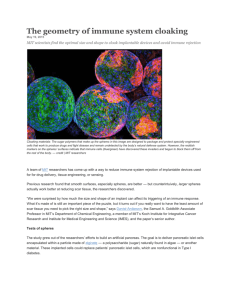Sodium Alginate Lab
advertisement

Name:______________________ Date:__________ An Investigation of the Enzyme Catalase Introduction Enzymes are catalytic proteins that speed up the rate of chemical reactions that would otherwise happen more slowly. A catalyst is a chemical agent that changes the rate of a reaction without being consumed by the reaction. You have hundreds of different enzymes in each of your cells. Each of these enzymes is responsible for one particular chemical reaction that occurs in the cell. In this lab, you will study catalase, an enzyme that is found in the cells of many living tissues, including those of plant, animal, and even fungus. Catalase speeds up a reaction that breaks down hydrogen peroxide, a toxic chemical, into 2 harmless substances-water and oxygen: 2H2O2 2H2O + O2 You may be surprised to find out that hydrogen peroxide is produced as a waste product in every cell of your body. It is a byproduct of many normal chemical reactions. If the cells did not break down the hydrogen peroxide, they would be poisoned and die. In cells, the enzyme catalase works on its substrate hydrogen peroxide converting it to harmless water and oxygen. The rate of this reaction can be determined by measuring the amount of oxygen produced. Yeast cells are encapsulated in sodium alginate, a non-toxic, easily obtainable, algal extract, to form uniform spheres. These spheres are dropped into H2O2 and the oxygen created as a byproduct in the reaction builds up on the sphere, causing it to float. The time it takes for the spheres to rise to the surface of H2O2 is measured. Depending on the catalase solution some of the reactions will happen faster than others, producing oxygen faster and the sphere will float sooner. Some background on Sodium Alginate: Sodium alginate is a non-toxic hydrophilic polysaccharide that is used as a thickening agent in foods such as ice cream, yogurt, and cake mixes because it helps to emulsify oil and water and give a smooth texture to foods. It is used by some chefs to make flavor “pearls” or “caviar” and it is also used to encapsulate yeast in the production of wine. When sodium alginate, a hydrophilic polymer, comes in contact with CaCl2, sodium ions are replaced with calcium. This leads to cross-linkages between the polymer chains and an insoluble gel is formed. If spheres with “tails” form when the yeast-sodium alginate solution comes in contact with the CaCl2 the yeast-sodium alginate solution may be too thick. If this is the case just thin it out with a bit of dH2O. 1 General procedure: Preparing the yeast/sodium alginate solution 1. Add 20ml of each of a 10% yeast (Saccharomyces cerevisiae) solution to a 2% sodium alginate solution (this solution is very viscous). Mix well with a glass rod. 2. Draw up the yeast -sodium alginate solution into a 30 ml syringe. Carefully wipe off all excess liquid from the syringe tip. Making the yeast spheres 1. Hold the syringe containing the yeast-sodium alginate solution over a beaker containing 50 ml of 0.15M CaCl2. Very slowly depress the plunger so that a drop of the yeast-sodium alginate solution falls into the beaker. A sphere should form as the drop comes in contact with the CaCl2 solution and fall to the bottom of the beaker. 2. Continue releasing yeast-sodium alginate drops into the 0.15M CaCl2 solution. Try to have spheres all of uniform size. The spheres should remain in this solution for about 5 minutes to harden. 3. Dispose of any floating spheres. 4. Obtain a small strainer and hold it over a clean beaker. Very carefully pour the contents of the beaker containing the yeast-sodium alginate spheres into the strainer. 5. Once drained, carefully rinse the spheres under a slow running faucet. 6. Pour the spheres into a petri dish or into a beaker. If not using immediately add 25 ml of water so the spheres don’t dry out. 2 Part A-The effect of enzyme concentration on the rate of the reaction What is your hypothesis about what will happen?______________________________ ____________________________________________________________________ ____________________________________________________________________ Procedure: 1. For this part of the experiment, you will need to make the following dilutions. Make each dilution as the protocol below calls for it. Do not make them all at the beginning. Table 1: Catalase Dilutions (based off of 3% H2O2 solution) Final quantity Concentration of mL of H2O2 needed final solution 50mL 1.5% 25 50mL .6% 10 50mL .3% 5 50mL 0% 0 For each of the above concentrations, you will do the following: mL of water 25 40 45 50 1. Pour 50 ml of the diluted hydrogen peroxide (H2O2) solution into a 50 ml graduated cylinder. 2. Using forceps, gently remove one yeast sphere from the petri dish or beaker. 3. Drop the sphere into the graduated cylinder. Start timing as soon as the sphere touches the surface of the hydrogen peroxide. Keep timing until the sphere reaches the surface again. Record data table 2, found below. 4. Dispose of the yeast sphere. Table 2: Reaction Rate (in seconds) of H2O2 Dilutions Trail Time for 1.5% Time for .6% Time for .3% (s) (s) (s) 1 2 3 4 5 6 7 8 9 10 Average 3 Time for 0% (s) Analysis Construct a line graph showing reaction rate versus the substrate concentration. Place substrate concentration on the x-axis and the reaction rate on the y-axis. Answer the following questions on a separate sheet of paper. 1. Why did you measure the distance traveled by the spheres to determine reaction rate? 2. Based on the graph and the overall slope of the line, what can you conclude about the effect of substrate concentration on reaction rate? 3. Is this procedure a good way to test enzyme activity? Explain your answer. Part B - Designing an experiment Once the basics of this set-up are understood, you are free to design an experiment to see what effect some variable will have on this enzymatic reaction. Make sure you write out their experimental design first before carrying out the experiment. Include a hypothesis. What is the control? What concentration(s) of substrate will be used? What temperature(s)? How many trials? Some topics to consider are temperature, pH, and catalase concentration. Replicates should be performed. Some suggestions relating to some of the topics to be considered: Temperature: For experiments that investigate different temperatures make sure the H2O2 and the yeast spheres are to the temperature to be tested before the experiment proceeds. Make sure you work quickly when looking at different temperatures so the temperature of the spheres or the H2O2 doesn’t get back to room temperature before they are done. The spheres may be put in water at the desired temperature to equilibrate. We have water baths available to you, if you would like to use them. pH: If testing the effect of pH on the reaction rate. You may want to try soaking the spheres for 10 minutes in the pH buffer to be tested and make the H2O2 dilutions in the pH buffer. At high and low pH the spheres can start to disintegrate. Salinity: If testing the effect of salt concentration on the reaction rate. You may want to try soaking the spheres for 10 minutes in the salt concentration to be tested and making the H2O2 dilutions in the same salt concentration. 4







